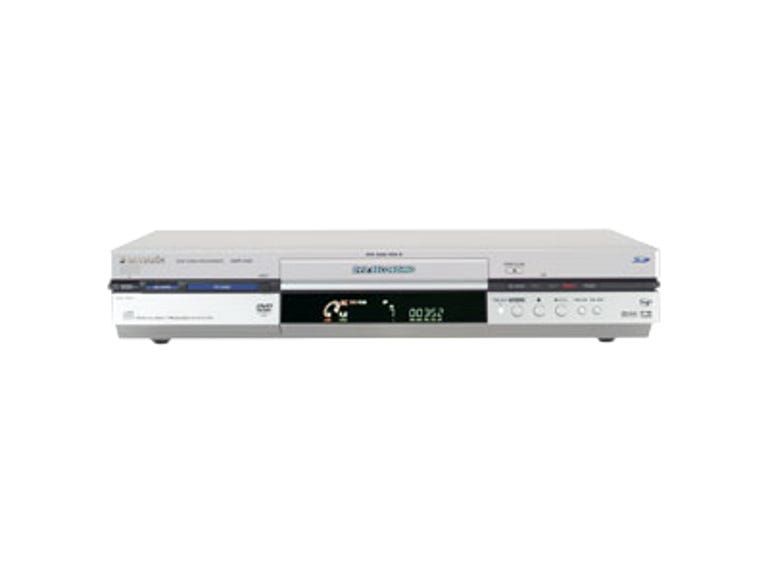 Why You Can Trust CNET
Why You Can Trust CNET Panasonic DMR-E60S review: Panasonic DMR-E60S
Panasonic DMR-E60S
The E60's somewhat thick case doesn't seem to match the cutting-edge product; in fact, we found the big DVD Recording logo on the drawer downright ugly. A skinny black belt across the silver face cleverly camouflages the two card slots, and the big, animated display organizes information well. We especially like the cool-looking spinning-disc icon that tells you the recording status at a glance.
The Good
The Bad
The Bottom Line
A series of bland, complex menus are the main way to access the E60's numerous functions. Understanding the options will be a chore for beginners, and the dense manual does a poor job of clearing things up.
Panasonic's new aluminum-skinned remote is an improvement over the plastic clunker you get with the DMR-HS2. However, the control's face is still crowded, and we would have appreciated more distinction between the three menu buttons. On the plus side, once we'd gotten used to the layout, we had no problem quickly accessing many of the functions.
Many of the E60's capabilities involve the two memory-card slots. The first accommodates a simple Secure Digital (SD) memory card, while the second accepts any PC Card adapter compatible with SD, CompactFlash, Smart Media, Memory Stick, xD-Picture Card, or Micro Drive media. In addition to offering slide shows and a standard photo-album display, the E60S can transfer JPEG images between cards or from a card to DVD-RAM. The machine cannot burn photos to DVD-R, edit stills or rotate them on the screen, or read music or movie files. The upcoming E100H can handle MPEG-2 and MPEG-4 video.
The DVD-RAM format allows the E60S to perform some of the tricks of hard-disk recorders. You can record one program while playing back another, watch an in-progress recording from the beginning, and perform basic editing such as shortening segments and dividing one program into two. Naturally, a PC is much better suited to more-advanced video editing.
Of the three rewritable DVD formats, DVD-RAM offers the least compatibility, but Panasonic says that Samsung and Hitachi will release more players with DVD-RAM capability. The E60S also records on write-once DVD-Rs, which "--="" rel="noopener nofollow" class="c-regularLink" target="_blank">&siteid=7&edid=&lop=txt&destcat=&destUrl=http%3A%2F%2Fwww%2Ecdrinfo%2Ecom%2FSections%2FArticles%2FSpecific%2Easp%3FArticleHeadline%3DDVD%2520Media%2520Format%2520Compatibility%2520Tests%26Series%3D0" target="new">almost all DVD players can handle. It can also play back DVD-Audio discs, but that's hardly a major selling point. Playback is stereo only, not multichannel as with most other DVD-A-capable units.
The E60S includes VCR Plus, but since the player cannot control a cable or satellite box, its real-world usefulness for TV recording is limited. On the front panel are a FireWire input and a set of A/V inputs with S-Video. Matching A/V connections are on the rear, along with an RF input and output for cable or an antenna--just like on a VCR. A pair of A/V outs with S-Video, a progressive-scan component-video output, and an optical digital output finish off the back panel. The only missing link is a component-video input.
As expected, the E60's video quality was superior to VHS's even when we chose the four-hour EP mode, in which recordings looked stable and had well-saturated colors but were tinged with blocky MPEG noise. Stepping up to the two-hour SP mode eliminated nearly all the MPEG blocks in the backgrounds. The one-hour mode smoothed the picture even further so that it was nearly indistinguishable from the original, even on our large Samsung HLN617W reference set.
Changing from SP to EP resulted in a serious dip in resolution: SP measured 450 lines, while EP came in at barely 230. You should avoid the six-hour LP mode; it is significantly softer than EP, tended to introduce stutter in pans, and managed just 200 lines of resolution.
To perform a side-by-side comparison between the E60S and Philips's DVDR80 recorder, we used the Monsters Inc. DVD via S-Video. Overall, the Panasonic in its one- and two-hour modes won by a very slight margin. The Philips tended to introduce more MPEG blocks, but its image looked a tiny bit sharper, especially with backgrounds and the walls of Sully and Mike's apartment. In the four-hour mode, the Philips edged out the Panasonic by a blue hair, giving Sully's coat noticeably more detail compared with the E60's oversmooth rendition. The Philips delivered an impressive 275 lines of resolution in EP mode.
Photo-viewing and -copying features worked as advertised, although the E60S was unable to display our TIFF test files. At one point, we tried a somewhat scuffed DVD-R blank. The player went into Recover mode and spit out the unusable disc. Progressive-scan DVD playback was fine, although we did notice some jagged edges in video-based material.


